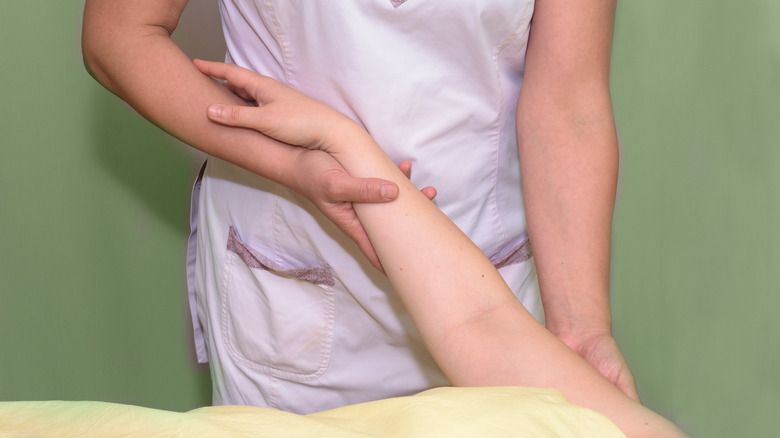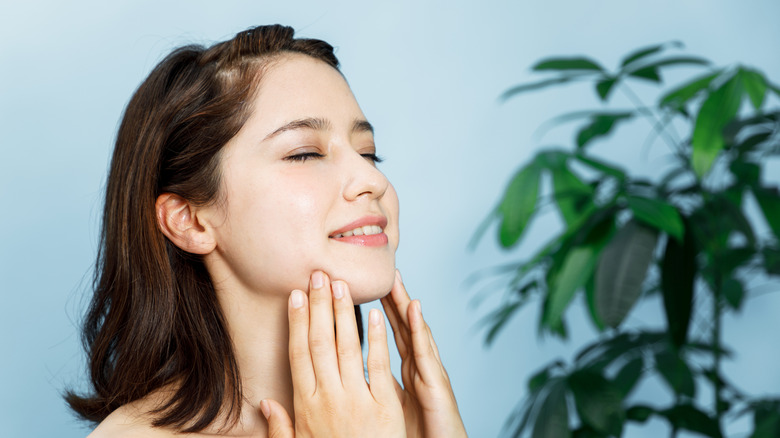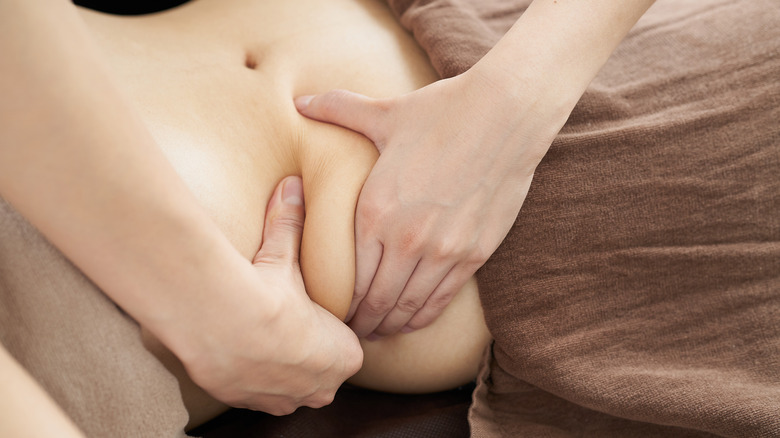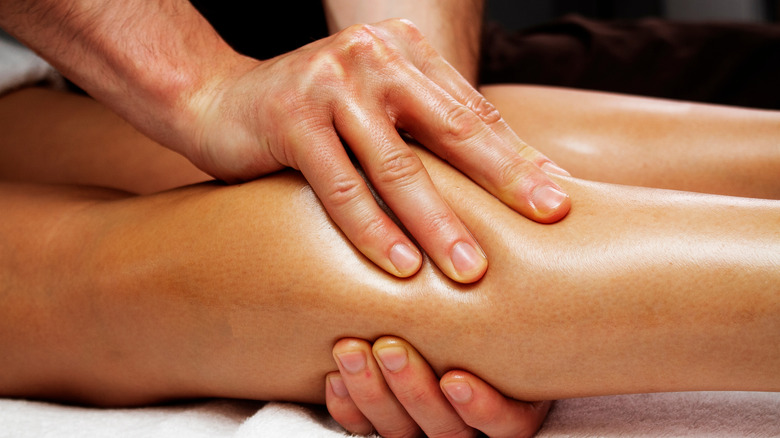How To Do A Lymphatic Drainage Massage At Home
The lymphatic system performs all sorts of marvels within the body. It moves and flushes waste, cleansing the human body of unwanted toxins. Sometimes the lymphatic system can become blocked and when that happens a lymphatic drainage massage may become necessary. This is something that can be performed by a certified physical therapist or massage therapist, according to Healthline. Or, it's something that can be performed at home by yourself.
When the lymphatic system gets blocked, swelling can occur as thick lymphatic fluid builds up in certain sections of the body, usually around the limbs. This is a condition known as lymphedema. According to the Mayo Clinic, there are two forms of lymphedema. Primary lymphedema can be hereditary and caused by conditions that alter the development of the lymphatic system. Secondary lymphedema, which is more common and can be caused by injury resulting from surgeries, chemotherapy, or cancer cells that block off the lymph vessels.
However lymphedema forms, a drainage massage can get the system moving again and add more comfort to your life.
Why a lymphatic drainage massage might be different than you think
When most people think of a lymphatic drainage massage, they think of the affected swollen area and often believe the massage will be performed focused 100% where the most lymphatic fluid has built up. However, the lymphatic system is a whole-body system, and that is why a lymphatic drainage massage is practically a whole-body process.
Nearly the whole lymphatic system drains by the left shoulder. The exceptions are the head, the right side of the chest, and the right arm, according to Healthline. Lymphedema therapists often start at the collar bone making half-circular motions to open up the system. That is called clearing and the first stage of lymphatic therapy. The second stage is called reabsorption.
During clearing, the massage will help create space where there is fluid buildup. Space encourages the fluid to circulate again. Reabsorption is how it sounds — making motions on different parts of the body so the lymphatic fluid is reabsorbed into the larger lymphatic system, according to Massage & Fitness Magazine.
Performing a DIY lymphatic drainage massage
To begin clearing, according to Healthline, you should be lying down with your arms crossed over your chest. Slowly lift your elbows. After this, you'll put one hand over your head as your other hand begins to massage it. Be gentle and start from the top using a scooping motion, moving your way down. Then, put your arm straight against the side of your body and use a pinching motion on the skin inside your elbow, moving across the area inch by inch. Again, make sure to use light pressure as you do this. The massage should push the fluid up, so allow the skin to relax back down on its own.
"In lymphatic massage, you're only working the superficial skin structure," Dr. Raakhee Patel told the outlet. He added that the fluid is trapped and built up near the surface of the skin. Make sure to do this on both sides of your body, even if your lymphedema is only on one side of the body or in your legs.
Lymphatic massage on the legs begins with the process described above before moving to your lower body. You should typically start with the upper legs, placing a hand on the inside of the leg and another on the back. Stretch the skin in this area upwards, and continue to do this as you work your way down your leg. When you get to your knee, you'll stretch your skin towards your armpit. Repeat this 10 to 15 times. This should help clear your lymphatic system before the absorption phase.
How to perform the reabsorption stage of a lymphatic drainage massage
To perform the reabsorption part of a lymphatic drainage massage, use different methods depending on what part of your body is most affected by lymphatic fluid buildup. Always begin as far away as possible from the affected area. If the lymphedema is by your arm, elbow, or shoulders, begin at the fingertips. If the lymphedema is in your legs, begin at the knee, according to Healthline.
On the arm, remember to always be gentle and use a sweeping motion to move the skin surface from your fingertips to your hands, and then from your hand to your elbow, and finally from your elbow all the way up to your shoulder.
When trying to reabsorb lymphatic fluid in your legs, place a hand behind each knee and use a pumping motion upwards, repeated 10 to 15 times. Once this is complete, you can attempt pushing up fluid from your lower leg by massaging that area. Place one hand behind your shin and the other hand on top and begin using an upward movement to stretch the skin. Release each patch of skin you stretch and continue with this motion until you reach the ankles. Finally, push on the bottom of your toes to propel lymphatic fluid upward to reabsorb and circulate throughout your lymphatic system.
Caring for yourself after a lymphatic drainage massage
There are also things that you should do following the lymphatic massage. Lymphatic massage expert Flavia Lanini told Vogue it's important to stay hydrated for the next 48 hours, so drink plenty of water. Lanini also said "avoiding alcohol, sugar, gluten, and sodium" during that period is a good idea, but that there is "no need to obsess."
Staying hydrated even after that 48 hour period could help overall. Healthline says that hydration is key for anyone who has lymphedema or lymphatic drainage issues, as hydration helps move waste along the body until the body releases it.
You can also use some type of compression sleeve or hose between massages to help contain fluid buildup. Dr. Raakhee Patel also told Healthline that lymphatic drainage massages should be used for maintenance between professional appointments. "This is a maintenance technique," he said. "Your lymphedema should not get worse if you regularly practice lymphatic massage."




